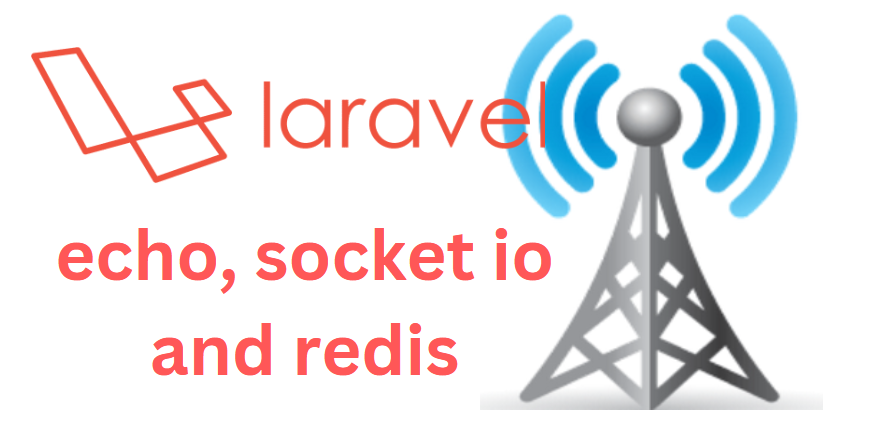Laravel Service Provider | Service Provider In Laravel In Hindi
Laravel Service Container Example | Service Container In Laravel In HIndi
How to setup MongoDB In Laravel : Laravel with MongoDB
Features of Laravel 9 : What is new in Laravel 9
Linux traceroute Command : traceroute Command In Linux
Web Performance In Hindi : Website Performance Kya Hai?
Linux Basic Commands With Examples In Hindi - Part 1
PHP object Type Casting In Hindi | PHP object In Hindi
JavaScript Spread syntax In Hindi : Spread Operator In JavaScript
If tutorials available on this website are helpful for you, please whitelist this website in your ad blocker😭 or Donate to help us ❤️ pay for the web hosting to keep the website running.

Laravel socket io
इस Blog में Laravel में echo , soecket io को redis के साथ implement करेंगे।
Laravel framework 5.6 or higher
laravel events
laravel-echo-server
socket io
Laravel में आप broadcasting भी implement कर सकते हैं , means किसी particular place से किसी event को emit करके एक या एक से ज्यादा places पर use listen कर सकते हैं।
इन events को socket की help से trigger और listen किया जाता है।
सबसे पहले एक fresh laravel project को composer की help से install कर लेते हैं -
composer create-project laravel/laravel chattest --prefer-dist
npm install
npm install laravel-echo
npm install socket.io-client
composer require predis/predis
अगर आप windows operating system पर हैं तो , आपको redis app install करना पड़ेगा और उसे port 6379 पर set करना है। और अगर mac / linux है तो आपको command line के through install करना है।
इसके बाद आपको php.ini file में extension=redis check करना है , अगर नहीं है तो आपको php_redis.dll file को download करके xampp/php/ext या wampp/php/ext directory में रख देनी है फिर php.ini file open करके extension=redis save करना है और server restart कर देना है।
npm install -g laravel-echo-server
अब .env file open करें और नीचे दी गयी lines को replace / add कर दें।
BROADCAST_DRIVER=redis CACHE_DRIVER=redis REDIS_HOST=127.0.0.1 REDIS_PASSWORD=null REDIS_PORT=6379 LARAVEL_ECHO_PORT=6001
hardware configuration के बाद आपको laravel echo server का config set करना है जहाँ पर आप define करेंगे कि किस port पर events को listen करेंगे।
configuration के set करने के लिए project की root directory में नीचे दी गयी command run कर दें।
laravel-echo-server init
ऊपर दी गयी command completely finish करने पर root directory में एक laravel-echo-server.json name से file बनेगी जिसमे कुछ इस तरह से configuration होगी।
{
"authHost": "http://localhost",
"authEndpoint": "/broadcasting/auth",
"clients": [],
"database": "redis",
"databaseConfig": {
"redis": {},
"sqlite": {
"databasePath": "/database/laravel-echo-server.sqlite"
}
},
"devMode": true,
"host": null,
"port": "6001",
"protocol": "http",
"socketio": {},
"secureOptions": 67108864,
"sslCertPath": "",
"sslKeyPath": "",
"sslCertChainPath": "",
"sslPassphrase": "",
"subscribers": {
"http": true,
"redis": true
},
"apiOriginAllow": {
"allowCors": false,
"allowOrigin": "",
"allowMethods": "",
"allowHeaders": ""
}
}यह वही port number लिया गया है जो हमने .env file में LARAVEL_ECHO_PORT में लिया था , अगर आप दूसरे port पर run करना चाहते हैं तो change कर सकते है।
अब एक event generate कर लेते हैं , event generate करने के लिए नीचे दी गयी command run करें -
php artisan make:event TestEventये command run करते ही app/Events directory में TestEvent.php file create होगी उसे open करें और नीचे दिया गया content रख दें।
<?php
namespace App\Events;
use Illuminate\Broadcasting\Channel;
use Illuminate\Queue\SerializesModels;
use Illuminate\Broadcasting\PrivateChannel;
use Illuminate\Broadcasting\PresenceChannel;
use Illuminate\Foundation\Events\Dispatchable;
use Illuminate\Broadcasting\InteractsWithSockets;
use Illuminate\Contracts\Broadcasting\ShouldBroadcast;
use Illuminate\Contracts\Broadcasting\ShouldBroadcastNow;
class TestEvent implements ShouldBroadcastNow
{
use Dispatchable, InteractsWithSockets, SerializesModels;
public $data = [];
/**
* Create a new event instance.
*
* @return void
*/
public function __construct($data = [])
{
$this->data = $data;
}
/**
* Get the channels the event should broadcast on.
*
* @return \Illuminate\Broadcasting\Channel|array
*/
public function broadcastOn()
{
return new Channel('TestEvent');
}
}Actually इस file में हम event name और event channel name define करते हैं , by default class name ही event name होते है। और $data में आपको वो data मिल जायगा जो event fire करने पर आप pass करेंगे।
event को आप कही भी fire कर सकते हैं बस आपको उस event class को add करना पड़ेगा और broadcast() method की help से आप event को fire कर पाएंगे। अभी मै web.php में ही event को fire कर रहा हूँ।
<?php
use Illuminate\Support\Facades\Route;
use App\Events\TestEvent;
Route::get('fire-event', function() {
broadcast(new TestEvent(["message" => "this is data passing to the event"]));
});
Route::view('listen-event', 'test-view');अब event को listen करने के किये test-view.blade.php file बना ले और नीचे दिया गया content रख दें।
<!DOCTYPE html>
<html>
<head>
<meta charset="utf-8">
<title>Listen Event</title>
</head>
<body>
<script>
window.laravel_echo_port='{{env("LARAVEL_ECHO_PORT")}}';
</script>
<script src="//{{ Request::getHost() }}:{{env('LARAVEL_ECHO_PORT')}}/socket.io/socket.io.js"></script>
<script src="{{ asset('public/js/laravel-echo-setup.js') }}" type="text/javascript"></script>
<script type="text/javascript">
try {
window.Echo.channel('TestEvent').listen('TestEvent', (data) => {
alert("Event is working");
console.log("data", data);
});
}
catch(e) {
console.log("Error while listening");
}
</script>
</body>
</html>blade file में हमने एक laravel-echo-setup.js file add की है , इसे setup करने के लिए resources/js directory में laravel-echo-setup.js file बना लें और नीचे दिया गया code रखकर save कर दें।
// file : resources/js/laravel-echo-setup.js
import Echo from 'laravel-echo';
window.Echo = new Echo({
broadcaster: 'socket.io',
host: window.location.hostname + ":" + window.laravel_echo_port,
enabledTransports: ['ws', 'wss'],
disableStats: true,
forceTLS: false,
transports: ['websocket', 'polling', 'flashsocket']
});अब आपके project root directory में webpack.mix.js file को open करें और नीचे दी गयी line को रख दें -
let mix = require('laravel-mix');
....
....
mix.js('resources/js/laravel-echo-setup.js', 'public/js');इसके बाद project root में command line open करें और npm run dev command run करें -
Finally ये सब configuration करने के बाद command line से नीचे दी गयी command को run करें-
laravel-echo-server startcommand run करने के बाद कुछ इस तरह से output दिखेगा -
L A R A V E L E C H O S E R V E R version 1.6.3 ⚠ Starting server in DEV mode... ✔ Running at localhost on port 6001 ✔ Channels are ready. ✔ Listening for http events... ✔ Listening for redis events... Server ready!
इसके बाद browser में दो tab open करें , एक से event fire करें और दूसरे में उस event को listen करें।
I Hope , आपको laravel में socket के साथ ये demonstration समझ आया होगा।
Loading ...

Hi ! I'm Rahul Kumar Rajput founder of learnhindituts.com. I'm a software developer having more than 4 years of experience. I love to talk about programming as well as writing technical tutorials and blogs that can help to others. I'm here to help you navigate the coding cosmos and turn your ideas into reality, keep coding, keep learning :)
Get connected with me. :) LinkedIn Twitter Instagram Facebook